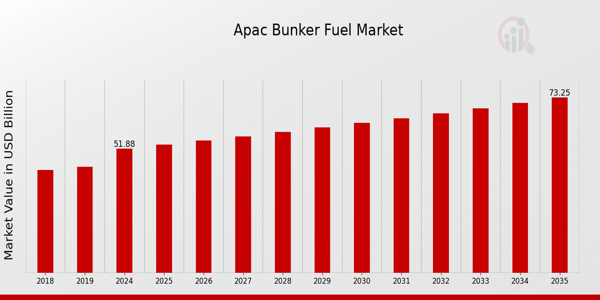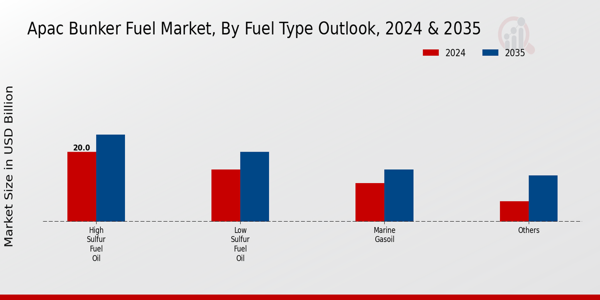APAC Bunker Fuel Market Overview
The APAC Bunker Fuel Market Size was estimated at 49.74 (USD Billion) in 2023. The APAC Bunker Fuel Market Industry is expected to grow from 51.88(USD Billion) in 2024 to 73.24 (USD Billion) by 2035. The APAC Bunker Fuel Market CAGR (growth rate) is expected to be around 3.185% during the forecast period (2025 - 2035).
Key APAC Bunker Fuel Market Trends Highlighted
The APAC Bunker Fuel Market is currently undergoing significant market trends that are being influenced by the region's rapid economic development and the escalating maritime activities. The increasing demand for shipping and logistics in countries like Japan, China, and South Korea is a significant market driver. The demand for marine fuels has been augmented as a result of the increase in international trade that has resulted from the expansion of these economies. Additionally, the IMO 2020 regulations, which impose stringent sulfur emission regulations, have incited a transition to low-sulfur fuel alternatives. This trend is promoting the use of bunker fuels that are more environmentally friendly, which is consistent with regional initiatives that prioritize environmental sustainability.
Opportunities in the APAC Bunker Fuel Market include the transition to LNG (liquefied natural gas) as a bunker fuel alternative, driven by its lower environmental impact and growing investment in related infrastructure. Countries like Singapore and Japan are actively promoting LNG bunkering to meet regulatory requirements and cater to the evolving demands of environmentally conscious shipping companies. Additionally, technological advancements in fuel management systems are enabling better efficiency and compliance, representing another avenue for growth. In recent times, the APAC region has seen a notable shift towards digitalization and automation within the bunker supply chain.This trend is reflected in the increased use of digital platforms for fuel procurement and real-time tracking of fuel quality and delivery. As the industry adapts to these technological improvements, the overall efficiency and transparency of the bunker fuel supply process are likely to enhance, ultimately benefiting stakeholders across the board. With ongoing developments and a proactive approach to addressing regulatory changes, the APAC Bunker Fuel Market is poised for continued evolution.

Source: Primary Research, Secondary Research, MRFR Database and Analyst Review
APAC Bunker Fuel Market Drivers
Growth in Maritime Trade in the APAC Region
The APAC Bunker Fuel Market Industry is experiencing significant growth thanks to the increasing volume of maritime trade in the region. According to the United Nations Conference on Trade and Development (UNCTAD), Asia accounts for over 50% of the global container port throughput, driven by booming economies such as China and India. The Asian Development Bank (ADB) has reported a projected growth of 6.3% in trade within developing Asia for the next few years, further raising the demand for bunker fuel.As maritime logistics become more crucial for trade, the requirement for efficient and reliable bunker fuel sources will become paramount. Major shipping organizations, such as the International Chamber of Shipping, emphasize the necessity of adopting cleaner and more sustainable bunker fuels to comply with new regulations. Thus, the growing maritime trade directly correlates with the demand for bunker fuel in the APAC region.
Implementation of IMO 2020 Regulations
The introduction of the International Maritime Organization (IMO) 2020 regulations, which reduces the allowable sulfur content in marine fuels, has had a significant impact on the APAC Bunker Fuel Market Industry. The regulations have led to a surge in demand for low-sulfur bunker fuels, as shipping companies are seeking to avoid hefty fines for non-compliance. The International Maritime Organization has noted a shift towards cleaner fuel alternatives, prompting many bunker suppliers in the APAC region to adapt their offerings.Furthermore, the use of scrubbers to mitigate sulfur emissions has increased, as reported by various maritime regulatory bodies. This transition is expected to sustain the growth of the bunker fuel market in APAC as companies strive for compliance and sustainability.
Investment in Port Infrastructure in APAC
Significant investments in port infrastructure across APAC countries are driving the growth of the Bunker Fuel Market Industry. Governments in the region, such as those in Singapore, China, and South Korea, are enhancing port facilities to accommodate larger vessels and improve operational efficiency. The Maritime and Port Authority of Singapore has announced investments of several billion dollars into port modernization projects. Improved infrastructure attracts more shipping companies, which in turn increases bunker fuel consumption as vessels spend more time within the port area.The emphasis on expanding and upgrading port facilities reflects the growing need for quality bunker fuels, sustaining market growth in the region.
APAC Bunker Fuel Market Segment Insights
Bunker Fuel Market Fuel Type Outlook Insights
The APAC Bunker Fuel Market is characterized by a diverse Fuel Type Outlook, encapsulating key components such as High Sulfur Fuel Oil, Low Sulfur Fuel Oil, Marine Gasoil, and Others. High Sulfur Fuel Oil has historically been favored due to its cost-effectiveness in specific applications; however, recent regulatory changes aimed at reducing sulfur emissions have prompted a shift towards Low Sulfur Fuel Oil. This transition reflects a growing commitment within the region to comply with stringent environmental regulations like the IMO 2020 rules promoting cleaner fuels.As a result, Low Sulfur Fuel Oil has seen significant uptake as marine operators adjust to these regulatory frameworks. Marine Gasoil also contributes notably to the APAC Bunker Fuel Market, especially among operators investing in cleaner-burning technologies and vessels designed to utilize this type of fuel. The increased demand for more efficient and environmentally friendly lubricants is driving the growth of marine gasoil, particularly in ports with strict emissions control areas. Other fuel types within the segment are increasingly being explored as alternatives to traditional fuels, offering unique benefits such as improved performance metrics and lower emissions.The regulatory backdrop of the APAC region is also a crucial driver influencing the Fuel Type Outlook, as countries work towards enhancing sustainability in maritime operations. Continued investments in research and development further underscore the importance of innovation in fuel solutions. Overall, the dynamics within the Fuel Type Outlook of the APAC Bunker Fuel Market are shaped by compliance, technological advancements, and environmental sustainability efforts, reflecting the region's strategic focus on greener maritime practices.

Source: Primary Research, Secondary Research, MRFR Database and Analyst Review
Bunker Fuel Market Commercial Distributor Outlook Insights
The Commercial Distributor Outlook in the APAC Bunker Fuel Market plays a critical role in shaping the industry's landscape. This segment comprises a diverse array of players, including Oil Majors, large independent distributors, and small independent distributors, each contributing to the overall market dynamics. Oil Majors, with their extensive logistical capabilities and established supply networks, often dominate the market, enabling them to meet the rising fuel demands driven by increasing shipping activities in the region. Large independent distributors have gained significance due to their flexibility and ability to tailor services to meet specific client needs, capitalizing on niche markets within the region’s evolving landscape.Meanwhile, small independent distributors provide competitive pricing and personalized services, carving out essential market segments despite facing challenges from larger players. The APAC region is witnessing robust growth in maritime activities, which works in favor of all distributors, as increased trade means higher bunker fuel consumption. Collectively, these distribution channels not only enhance market accessibility but also influence pricing and service standards, making them integral to the APAC Bunker Fuel Market's development and resilience.
Bunker Fuel Market Application Outlook Insights
The APAC Bunker Fuel Market Application Outlook encompasses various critical segments, each playing a vital role in the maritime industry. The container segment is pivotal due to the increasing global trade and demand for efficient transportation of goods, which drives the need for reliable fuel sources. Bulk carriers, instrumental for transporting sizeable cargo, also significantly contribute to the overall fuel consumption, as their operations span vast distances across oceanic trade routes. Oil tankers remain essential for transporting crude and refined oil, forming the backbone of energy distribution in the region.Meanwhile, the general cargo segment shows versatility, catering to diverse shipping needs and impacting the overall bunker fuel demand. Chemical tankers are increasingly recognized for their niche role in transporting hazardous materials, emphasizing the need for specialized fuel solutions tailored for safety and efficiency. Fishing vessels, while traditionally smaller in scale, benefit from enhanced fuel types for improved operational sustainability. Gas tankers are gaining traction as the shift towards cleaner energy sources expands, with increased imports of liquefied natural gas (LNG) becoming prominent.Lastly, the 'Others' category captures various emerging vessel types and niche markets that are adapting to environmental regulations, thus presenting growth opportunities within the APAC Bunker Fuel Market. The trends indicate a steady demand for innovative and efficient fuel solutions driven by regulation, technology, and environmental considerations across all these segments.
APAC Bunker Fuel Market Key Players and Competitive Insights
The competitive landscape of the APAC Bunker Fuel Market has evolved significantly in recent years, driven by increasing maritime trade and stringent environmental regulations. The region is characterized by a diverse mix of local and international players vying for market share, promoting innovation, and improving their service offerings. Market participants are strategically positioning themselves through joint ventures, mergers, and acquisitions to enhance their supply chain efficiency and broaden their customer base. Factors such as fluctuating oil prices, regulatory changes, and the shift towards low-sulfur fuels have intensified competition, causing companies to adopt more flexible pricing strategies and invest in technology for better operational efficiencies. The impact of regional policies and economic growth across different APAC nations has propelled a competitive arena where companies continuously strategize to meet the increasing demand for bunker fuels.Chevron has established a formidable presence in the APAC Bunker Fuel Market, leveraging its extensive supply network and strong brand reputation. The company's strengths lie in its reliable product quality and an unwavering commitment to sustainability, positioning it favorably amid evolving regulations focused on emissions reduction. Through strategic relationships and partnerships within the region, Chevron has fortified its distribution capabilities, ensuring a consistent supply of high-quality fuels to various shipping companies and marine fleets. The company’s expertise in refining and its ability to adapt to market dynamics enable it to actively respond to customer needs, thus enhancing its competitiveness in the diverse APAC markets. By focusing on innovation and sustainability, Chevron remains a key player in shaping the future of bunker fuel supply in the region.Cargill has carved out a significant niche within the APAC Bunker Fuel Market by offering a diverse range of products and services tailored to meet the demands of its clients. Known for its strong logistical capabilities and commitment to providing high-quality marine fuel, Cargill enhances its market presence through comprehensive risk management solutions and flexible contracting options. The company aims to deliver exceptional customer service, which is facilitated by its extensive experience and understanding of local markets. Notably, Cargill’s strategic partnerships and collaborations in the region have resulted in a more robust supply chain that supports various customers, including shipping lines and port facilities. With an eye towards sustainability, Cargill has also been involved in initiatives promoting cleaner marine fuel alternatives. The company's strategic mergers and acquisitions efforts further underscore its ambition to enhance its competitive edge and secure a strong foothold in the APAC Bunker Fuel Market.
Key Companies in the APAC Bunker Fuel Market Include
- Chevron
- Cargill
- World Fuel Services
- Shell
- TotalEnergies
- PetroChina
- Singapore Marine
- Aegean Marine Petroleum
- Knightsbridge Shipping
- Bunker Holding
- Panocean Group
- HAPAGLloyd
- BP
- ExxonMobil
- Fuji Oil
APAC Bunker Fuel Market Industry Developments
The APAC Bunker Fuel Market continues to experience dynamic changes, marked by a notable increase in demand driven by the resurgence in maritime trade following pandemic-related disruptions. Recent developments indicate Chevron and BP ramping up efforts to enhance their supply chains in key locations such as Singapore, which remains the world’s leading bunkering hub. In October 2023, Cargill announced the expansion of its bunker fuel services in Asia, aligning with the region's growing energy needs while adhering to stricter emissions regulations. Amidst these developments, World Fuel Services has been actively optimizing its operational strategies to bolster market share in the APAC region. Moreover, Shell remains committed to sustainability initiatives by investing in low sulfur bunkering options. While no significant mergers or acquisitions have been reported recently, past years showed that PetroChina acquired multiple regional supply firms in 2022, further consolidating their position in the market. Over the last few years, the APAC Bunker Fuel Market has also reacted to fluctuations in global oil prices, significantly impacting profit margins across companies like TotalEnergies and ExxonMobil. Overall, the focus on compliance and sustainability continues to shape the future of the APAC Bunker Fuel Market.
APAC Bunker Fuel Market Segmentation Insights
Bunker Fuel Market Fuel Type Outlook Outlook
- High Sulfur Fuel Oil
- Low Sulfur Fuel Oil
- Marine Gasoil
- Others
Bunker Fuel Market Commercial Distributor Outlook Outlook
- Oil Majors
- Large Independent Distributor
- Small Independent Distributor
Bunker Fuel Market Application Outlook Outlook
- Container
- Bulk Carrier
- Oil Tanker
- General Cargo
- Chemical Tanker
- Fishing Vessels
- Gas Tanker
- Others
| Report Attribute/Metric Source: |
Details |
| MARKET SIZE 2018 |
49.74(USD Billion) |
| MARKET SIZE 2024 |
51.88(USD Billion) |
| MARKET SIZE 2035 |
73.24(USD Billion) |
| COMPOUND ANNUAL GROWTH RATE (CAGR) |
3.185% (2025 - 2035) |
| REPORT COVERAGE |
Revenue Forecast, Competitive Landscape, Growth Factors, and Trends |
| BASE YEAR |
2024 |
| MARKET FORECAST PERIOD |
2025 - 2035 |
| HISTORICAL DATA |
2019 - 2024 |
| MARKET FORECAST UNITS |
USD Billion |
| KEY COMPANIES PROFILED |
Chevron, Cargill, World Fuel Services, Shell, TotalEnergies, PetroChina, Singapore Marine, Aegean Marine Petroleum, Knightsbridge Shipping, Bunker Holding, Panocean Group, HAPAGLloyd, BP, ExxonMobil, Fuji Oil |
| SEGMENTS COVERED |
Fuel Type Outlook, Commercial Distributor Outlook, Application Outlook |
| KEY MARKET OPPORTUNITIES |
Increased demand for low-sulfur fuels, Expansion of LNG bunkering infrastructure, Growth in maritime trade volumes, Adoption of digital bunker management solutions, Investments in eco-friendly shipping technologies |
| KEY MARKET DYNAMICS |
Increasing demand for shipping, Regulatory compliance challenges, Price volatility of crude oil, Shift to low-sulfur fuels, Growth of marine renewable energy |
| COUNTRIES COVERED |
China, India, Japan, South Korea, Malaysia, Thailand, Indonesia, Rest of APAC |
Frequently Asked Questions (FAQ) :
The APAC Bunker Fuel Market is expected to be valued at 51.88 USD Billion in 2024.
By 2035, the overall market is projected to reach 82.44 USD Billion.
The market is expected to witness a CAGR of 4.3 percent from 2025 to 2035.
High Sulfur Fuel Oil is projected to have the largest market share, valued at 20.0 USD Billion in 2024.
Low Sulfur Fuel Oil is expected to be valued at 15.0 USD Billion in 2024.
Major players in the market include Chevron, Equinor, PetroChina, TotalEnergies, and ExxonMobil.
Marine Gasoil is projected to reach a market value of 15.0 USD Billion by 2035.
The market growth is driven by increasing maritime trade and regulatory changes in fuel specifications.
'Others' is expected to be valued at 6.88 USD Billion in 2024.
The APAC Bunker Fuel Market is expected to grow steadily, reflecting a positive trend in maritime fuel consumption.
The APAC Bunker Fuel Market is expected to be valued at 51.88 USD Billion in 2024.
By 2035, the APAC Bunker Fuel Market is expected to reach a value of 73.24 USD Billion.
The expected CAGR for the APAC Bunker Fuel Market from 2025 to 2035 is 3.185%.
High Sulfur Fuel Oil will have the highest value, estimated at 20.0 USD Billion in 2024.
The estimated market value for Low Sulfur Fuel Oil in 2024 is 15.0 USD Billion.
Some major players include Chevron, Shell, BP, and ExxonMobil.
Marine Gasoil is valued at 11.0 USD Billion in the APAC Bunker Fuel Market for 2024.
'Other' fuel types are projected to reach a market size of 13.24 USD Billion by 2035.
Growth drivers include increased shipping activities and regulatory changes in fuel standards.
The market is adapting through innovation in fuel technology and investment in cleaner fuel options.
















